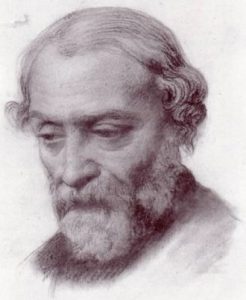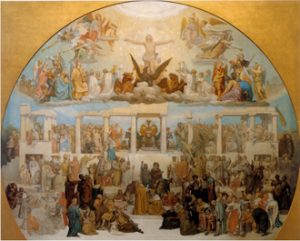
In art, the question of equality is posed in many different ways. Thomas Schlesser, whose excellent books on the nineteenth century we are familiar with, returns here to the artist’s propensity to vie with history. Through the case of Paul Chenavard, he offers us an example of an egalitarian and spiritual dreamer who wanted everything to be on the same level and in harmony in his work, though nothing, or next to nothing, in real life. What in particular he allows us to grasp is the extent to which it can be dangerous to want equality while also retaining a special status for the artist as a prophet–unless, that is, one also invents new objects, new statuses.
Laurence Bertrand Dorléac
Paul Chenavard
The Equal of
History
Thomas Schlesser
Paul Chenavard (1807-1895) shared with Tocqueville a significant distrust of the passion for equality. A staunch supporter of the Republic and a declared anticleric, this artist originally from Lyon who devoted his life to a major project he never completed–a Palingénésie universelle (Universal palingenesis) describing the crucial stages in human history–wished, like his friend the critic Gustave Planche, to retain a special status for creative artists and, especially, an extremely lofty mission for what they produce. He thus rose up against those associated with Realism, against any leveling of the hierarchy of genres, and against the idea that there is an equivalence between the edifying calling of grand painting and what he viewed as the more commercial and decorative vocation of landscape and still-life painting. Chenavard certainly acknowledged that people were reveling in the democratization of taste, but, by way of a corollary, he deplored the aesthetic decline this phenomenon engenders.
Chenavard can be registered as an opponent of this tendency also because he himself had no cause to be jealous of the equality of conditions that, according to Tocqueville, had become a harmful passion for the society that has had a taste of it.[ref]“The particular and dominant fact that makes such centuries unique is the equality of conditions; the principal passion that stirs men in such times is love of that equality. Do not ask what singular charm men in democratic ages see in living as equals, or what particular reasons they may have for clinging so stubbornly to equality rather than to the other goods society has to offer. Equality constitutes the distinctive characteristic of the era in which we live. That alone is enough to explain why they prefer it over all the rest.” Alexis de Tocqueville, Democracy in America, trans. Arthur Goldhammer, vol. 2, part 2, ch. 1 (New York: The Library of America, 2004), p. 582. [/ref] Benefitting from extraordinarily miraculous and substantial financial support his whole life long, this artist from Lyon embraced the career of being a painter without having to worry about selling anything at all, and still less about being engaged in any sort of mass production. For him, creating art was an absolute.
Like Goethe, and especially like Friedrich Nietzsche in the second of his Untimely Meditations, Chenavard found the spread of knowledge to have relevance only on the condition that it would stimulate the commitment and energy of actual living beings. When thinking of the artist in the noblest sense of the term, Chenavard spoke of a “director [réalisateur]”[ref]See Paul Mariéton’s interview with Chenavard, reprinted in vol. 6 of Marie-Antoinette Grunewald’s 1983 Sorbonne disseration, Paul Chenavard, lyonnais, peintre et philosophe et son environnement social, p. 301. [/ref] (or an “operant”), which he contrasted with “advocates” (the latter being individuals drowning in their speech). And, as a “director,” he endeavored to make things visible and known in order to induce one to act. Of course, by its erudition, Chenavard’s painting does some history (historiam rerum gestarum), but this narrative is destined to make History (res gestas).
Syncretist Ambitions

Paul Chenavard, Palingénésie sociale, Lyon, Musée des Beaux-Arts.
What exactly was this Palingénésie universelle? It was a frieze narrating the becoming of the world, as inspired by numerous readings (those of Pierre-Simon Ballanche, the author of the Essais de Palingénésie sociale, in 1827), encounters (with Hegel and the mystical German painters Peter von Cornelius and Johann Friedrich Overbeck, in 1828), pictorial models (the compositions of Raphael), and, more generally, by the worship of great men. Conceived over a two-decade period, it almost came to adorn the Panthéon, thanks to a commission granted by the French Republic in 1848, but it was ultimately driven out from there under the Second Empire. The images, painted in grisaille, were linked together in such a way as to lay out a chronology of the key periods of history as well as the basic breaks in it: foundational conflicts (The Trojan War, Attila, etc.), births of beliefs (The Sermon of Jesus Christ, Luther Burning the Decretals, etc.), instances of scientific progress (Hippocrates at the Bedside of the Sick, The Discovery of Printing, etc.), and the radiant influence of the mind (The Age of Louis XIV, Voltaire’s Staircase, etc.). Chenavard had also planned ornamental tiling on the floor, where one would see Hell, Purgatory, Paradise, and the Crucifixion. Finally, as the culminating point of this entire arrangement, there was to be one last image that would unify, beyond all conflict and in a kind of finally found Harmony, the distinguished figures of History, whether they be mythical, allegorical, religious, political, scientific, or artistic.
This ultimate Harmony, which was to constitute the central mosaic in the ornamental tiling located beneath the copula of the Panthéon, was to be made up of 158 characters. It served as a point of convergence. Several times between 1830 and 1848, Chenavard had reconsidered and revised his plan, which certainly merits a keen examination, for it extols a surprising form of egalitarianism that, it turns out, spelled its author’s ruin. In its very first version, this composite image appeared in the form of a circle that offered a synthesis, through a sort of dazzling shortcut, of Past, Present, and Future, the last of which, according to the descriptions left to us by Théophile Gautier, was to be cataclysmic.[ref]See Théophile Gautier, “Le Panthéon, les peintures murales,” in L’Art moderne (Paris: Michel Lévy, 1856).[/ref] Yet only two thirds of this initial project remained, since the Future was cut out. The exact circumstances surrounding Chenavard’s alteration and,all the more so, the motivations behind it are unknown to us. The following hypothesis can nonetheless be advanced: the painter wanted to avoid interfering with the congenial feelings his syncretic vision was fostering by offering an alarmist outlook, and he was inviting his viewers, without wanting to discourage them, to achieve on Earth the “harmonian utopia” they had before their eyes.
For, it really was that sort of utopia that was at issue here. One may note immediately that (unlike in the “convergent” images) there are no confrontations, no conflicts between protagonists. Everybody lives together, discusses with one another, and engages in exchanges, as if immune to the passions of History. In this version of the mosaic, one has a sense that the past and the present are united in a timelessly peaceful world, in a dream of happiness, a dream of Harmony wherein forces one thought were antagonistic are seen to be mutually tolerant and welcoming. Chenavard sacrificed, iconographically speaking, to the passion for equality. But that passion, it is quite obvious, had nothing to do with the passion for the equality of conditions, which he repudiated as much as Tocqueville did.
Equality Led Astray
Among the numerous reasons why Chenavard was prevented from carrying his project through to a successful conclusion, there is one that directly echoes the issues we have been examining in this seminar. It was indeed equality of opportunity–which is inherent in every good republican system–that hampered the completion of the Palingénésie. Let us explain.
In such a hurry to serve as the artistic stimulus for a new regime, its tutelary guide, Chenavard did not realize that the conditions under which he was awarded the Panthéon commission were fundamentally antirepublican. Indeed, it was after a personal meeting with the Minister of the Interior, Alexandre Auguste Ledru-Rollin, that, by a decree of April 18, 1848, Chenavard was given the responsibility for executing a series of mural paintings for the interior of the Panthéon that would be in conformity with the proposal he had presented to the Minister. This opportunity came to him without competition, based on a direct conversation with the established power. Numerous artists were keeping a close eye on the cultural policy of the new authorities, and the windfall offered to Chenavard did not please them one bit. Here is what Jean-Louis Bezard, one of the Lyonnais painter’s allies, related:
I’ve just come from a meeting of artists [held the same day the decree came out] which took place in the Chamber of Deputies. I learned there that you had been entrusted with the interior decoration of the Panthéon, and I was just beginning to rejoice when I was shown a Protest addressed to the Minister, already filled with a large number of signatures, that criticized the way in which the work had been attributed and, at the same time, the choice of the Artist: it was labeled favoritism, an injustice.[ref]Letter from Bezard to Chenavard, April 18, 1848, Lyon Municipal Library, MS. 5414. [/ref]
In a letter, an anonymous painter rightly reproached Ledru-Rollin for this step back toward a contentious system of decision-making combined with a, to say the least, curious choice, since the lucky man had neither produced nor shown anything in the way of monumental decoration. The letter was published in L’Artiste, and the response from the managing editor, Arsène Houssaye, was not lacking in piquancy. Houssaye justified the choice of Chenavard by praising his qualities as a “great painter,” an “orator in painting” whom he had seen in mediation in front of Michelangelo’s fresco at the Vatican.[ref]Arsène Houssaye, L’Artiste, April 30, 1848. [/ref] Houssaye added, moreover, that this “excellent idea . . . [would] open up a national workshop for young artists.”[ref]Ibid. [/ref] National workshop was a strong phrase. It meant that Chenavard’s construction site constituted a job reservoir to help offset the destitute state of young artists. It was as if the harmonious conformance between the highly selfless, long-term project of the Lyonnais painter and the lovely gift the provisional government had granted him was going to permit no more nor less than the satisfaction, on an egalitarian basis, of the monetary needs of countless Parisian daubers. But this “national workshop” that was being created around Chenavard posed a considerable number of problems. And far from offering an answer to the job shortage among artists, it generated a high degree of contestation, which Taxile Delord related simply as follows:
A host of painters appeared [on the construction site], thinking that they had found there the national workshops for painters. Their assistance having been rebuffed, they circulated among the numerous clubs then in existence a sort of protest message against the way in which this major project that was going to be undertaken at the Panthéon was being carried out.[ref]Taxile Delord, Histoire du Second Empire, vol 6 (Paris: G. Baillière, 1876), reprinted in Thomas Schlesser, Paul Chenavard, monuments de l’échec (1807-1895) (Dijon: Presses du Réel, 2009), pp. 251-56.[/ref]
No fewer than three-thousand signatures were gathered to denounce a way of proceeding that was all the more unjust as the wages being offered (a handout of ten francs a day) were considered “demeaning for art.”[ref]Ibid. [/ref]
An Equivalence of Motives
Let us note, nonetheless, that the final downfall of the Palingénésie ensued not so much from the protests of frustrated artists as from the religious authorities. For, with the Catholics’ official recovery of the Panthéon in December 1851, they could not tolerate the spiritual egalitarianism of Chenavard’s representation of a hamonian dream. As Albert du Boys explained in L’Ami de la religion:
The plan for the Panthéon mural paintings, as it was designed and as it is continuing to be carried out, is an incredible jumble of the most contradictory ideas, the most varied beliefs, the most contrasting symbols. All the Gods of Greece and of India, as well as those of Rome and of Scandinavia, occupy a place equal to that given there to the one true God; Olympus and Valhalla are no less elevated there than Calvary.[ref]Albert du Boys, “Congrès des diverses académies de France,” an article that appeared in L’Ami de la Religion, journal ecclésistique, politique et littéraire, 151 (March 4, 1851). Reprinted in Thomas Schlesser, op. cit., pp. 237-42.[/ref]. »
Antisyncretic condemnation did not halt there. This Catholic began to imagine characters who did not appear. In particular, he declared that the Lyonnais artist was getting ready to represent Charles Fourier:
There are apotheoses for the celebrated philosophers of all centuries and even for the utopians of the nineteenth century. Pythagoras and Charles Fourier, we shall dare say, are being represented there alongside the Son of God![ref]Ibid.[/ref]
In 1852, Monsignor Sibour, the Archbishop of Paris at the time, met with Chenavard. The latter having refused to alter his iconography,[ref]He did not repeat this lovely example of intransigence when, while presenting his Divina Tragedia to the Salon in 1869, he was enjoined to alter completely, in the Salon’s accompanying booklet, the message of his work. While it was initially supposed to represent the death of all religions, the picture became, in the wake of an act of censorship Chenavard did not defy, the triumph of Christianity. On this topic, see in particular Paul-Casimir Périer, Propos d’art à l’occasion du Salon de 1869 (Paris: Michel Lévy, 1869).[/ref] he was driven out of the monument, and from that time on he brooded over this dismissal, carrying it around with him for a half century as a traumatic event. Chenavard dreamed of equality only on the condition that he retain for himself the aristocratic status of artist-prophet. Faced with his failure, he became enmeshed in a melancholic state that led him to criticize unceasingly the concomitant decline of creative artistry and Humanity. What he did not see, or what he did not want to see, was the emergence, during this period, of a new status for artists that reinforced the obsolescence of his own: that of a rabble-elite, of Bohemian prophets, raised up by the movements of Realism, Naturalism, Impressionism, and Neo-Impressionism. Those movements, too, though in a wholly different manner, aspired to guide people’s worldview. And this time, the economy of means was breathtaking–“With an apple, I will astonish Paris,[ref] Statement first reported by Gustave Geffroy et reprinted in Michael Doran, ed., Conversations avec Cézanne (Paris, Macula, 1986), p.4.[/ref]» as Paul Cézanne said–and it was based, moreover, on an undifferentiated perception of nature, on a kind of perception that is without distinction. This principle could, according to the writer and critic Edmond About, be summarized as follows: “All objects are equal before painting.”[ref]Edmond About, Nos artistes au salon de 1857 (Paris: Hachette, 1858), p. 14.[/ref] Thus, during the second half of the nineteenth century, the passion for equality began, in the view of Chenavard, to rule over art. And for him, everything was henceforth really just all the same [à qui tout cela était désormais bien égale].
Bibliography
BERGDOLL, Barry. “Le Panthéon/Sainte Geneviève au XIXe siècle.” Le Panthéon. Symbole des révolutions. Paris: Caisse Nationale des Monuments Historiques et des Sites, 1989.
CHAUDONNERET, Marie-Claude. Ed. Paul Chenavard. Le peintre et le prophète. Lyon, Musée des Beaux-Arts exhibition, June 8-August 27, 2000. Paris: Réunion des Musées Nationaux, 2000.
DOUPHIS, Pierre-Olivier. Paul Chenavard dessinateur. Doctoral Thesis. Directed by Professor Bruno Foucart. Université Paris IV-Sorbonne. Thesis defense: November 24, 2001.
GRUNEWALD, Marie-Antoinette. Paul Chenavard, lyonnais, peintre et philosophe et son environnement social. State doctoral thesis. Sorbonne, 1983. 11 volumes.
McWILLIAM, Neil. Dreams of Happiness: Social Art and the French Left, 1830-1850. Princeton, NJ: Princeton University Press, 1993.
PÉLADAN, Joséphin. La Décadence esthétique, l’art ochlocratique. Paris: Dalou, 1888.
SCHLESSER, Thomas. Paul Chenavard, monuments de l’échec (1807-1895). Dijon: Presses du Réel, 2009.
SILVESTRE, Théophile. Histoire des artistes vivants. Paris: Blanchard, 1856.
SLOANE, Joseph C. Paul Marc Joseph Chenavard, Artist of 1848. Chapel Hill: The University of North Carolina Press, 1962.
Le Temps de la peinture, Lyon 1800-1914. Lyon, Musée des Beaux-Arts exhibition, April 19-July 30, 2007. Lyon: Fage Éditions, 2007.
THIÉBAULT-SISSON, François. “Au jour le jour.” Le Temps, Sunday, April 14, 1895.
Thomas Schlesser is an art historian, a journalist for Beaux-Arts Magazine, and a teacher at the École Supérieure d’Arts Graphiques Penninghen. He has published numerous works, including Réceptions de Courbet, fantasmes réalistes et paradoxes de la démocratie (1848-1871) (Dijon: Presses du Réel, 2007) and Paul Chenavard, monuments de l’échec (1807-1895) (Dijon: Presses du Réel, 2009).


